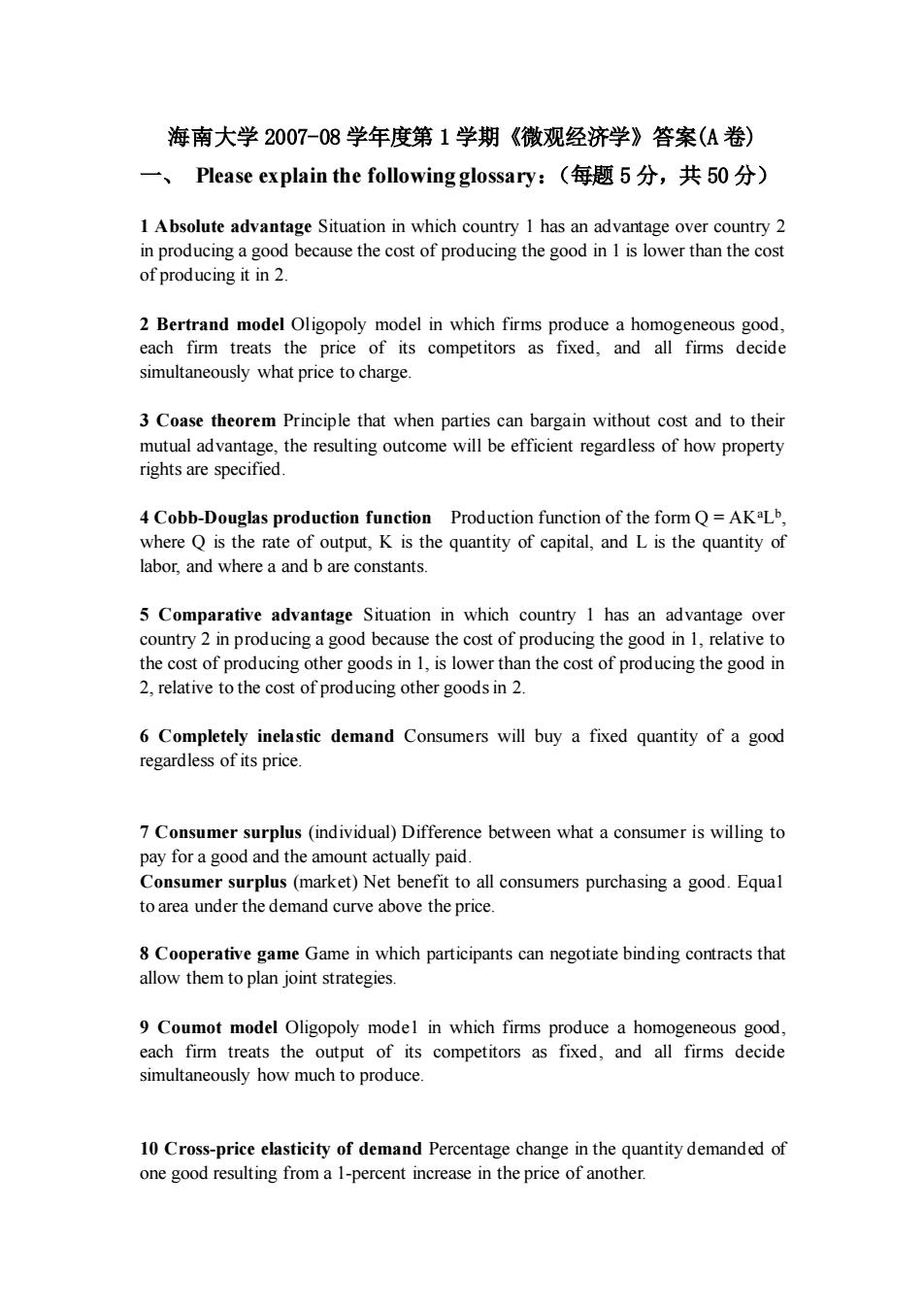正在加载图片...

海南大学2007-08学年度第1学期《微观经济学》答案(A卷) 一、Please explain the following glossary::(每题5分,共50分) 1 Absolute advantage Situation in which country 1 has an advantage over country 2 in producing a go d because the cost of producing the good in 1 is lower than the cost of producing it in 2 2 Bertrand model Oligopoly model in which firms produce a homogeneous good. each firm treats the price of its competitors as fixed.and all firms decide simultaneously what price to charge 3 Coase theorem Principle that when parties can bargain without cost and to their mutual advantage,the resulting outcome will be efficient regardless of how property rights are specified. 4 Cobb-Douglas production function Production function of the formQ=AKL where Q is the rate of output,K is the quantity of capital,and L is the quantity of labor,and where a and b are constants. 5 Comparative advantage Situation in which country I has an advantage over country 2 in producing a good because the cost of producing the good in1.relative to the cost of producing other goods in 1,is lower than the cost of producing the good in 2,relative to the cost of producing other goods in 2. 6Completely inelastic demand Consumers will buy a fixed quantity of a good regardless of its price 7 Consumer surplus(individual)Difference between what a consumer is willing to pay for a good and the amount actually paid. r(aket)Nebn t onms purchaindEu er the demand curve above the price 8 Cooperative game Game in which participants can negotiate binding contracts that allow them to plan joint strategies. 9Coumot model Oligopoly model in which firms produce a hon ogeneous good each firm treats the output of its competitors as fixed,and all firms decide simultaneously how much to produce. 1Cro-ric Percentage change in the demandd of one good resulting from a I-percent increase in the price of another. 海南大学 2007-08 学年度第 1 学期《微观经济学》答案(A 卷) 一、 Please explain the following glossary:(每题 5 分,共 50 分) 1 Absolute advantage Situation in which country 1 has an advantage over country 2 in producing a good because the cost of producing the good in 1 is lower than the cost of producing it in 2. 2 Bertrand model Oligopoly model in which firms produce a homogeneous good, each firm treats the price of its competitors as fixed, and all firms decide simultaneously what price to charge. 3 Coase theorem Principle that when parties can bargain without cost and to their mutual advantage, the resulting outcome will be efficient regardless of how property rights are specified. 4 Cobb-Douglas production function Production function of the form Q = AKaL b , where Q is the rate of output, K is the quantity of capital, and L is the quantity of labor, and where a and b are constants. 5 Comparative advantage Situation in which country 1 has an advantage over country 2 in producing a good because the cost of producing the good in 1, relative to the cost of producing other goods in 1, is lower than the cost of producing the good in 2, relative to the cost of producing other goods in 2. 6 Completely inelastic demand Consumers will buy a fixed quantity of a good regardless of its price. 7 Consumer surplus (individual) Difference between what a consumer is willing to pay for a good and the amount actually paid. Consumer surplus (market) Net benefit to all consumers purchasing a good. Equa1 to area under the demand curve above the price. 8 Cooperative game Game in which participants can negotiate binding contracts that allow them to plan joint strategies. 9 Coumot model Oligopoly mode1 in which firms produce a homogeneous good, each firm treats the output of its competitors as fixed, and all firms decide simultaneously how much to produce. 10 Cross-price elasticity of demand Percentage change in the quantity demanded of one good resulting from a 1-percent increase in the price of another